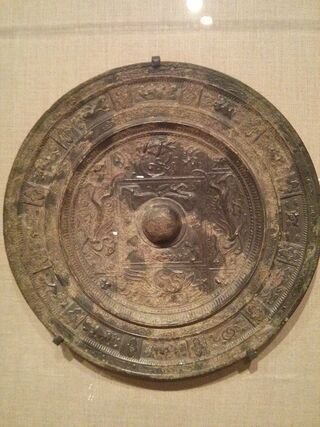Bronze mirrors

Bronze mirrors were a major prestige good held by elites in Yayoi period and Kofun period Japan. They have been found in great numbers in burials across the region, in Japan, Korea, and China, and are associated with rulership both as a symbol of the sun (the brightness reflected in the polished metal), and therefore of Amaterasu and divine emperorship, and as a simple indicator that the holder of such mirrors possesses the wealth and power to have been able to obtain such prestige objects. Their significance is further indicated by the discussion of bronze mirrors (or "sun mirrors") as goods valued, or at least possessed, by the gods, in texts such as the Nihon Shoki and Kojiki; the most famous of these is Yata no kagami, a mirror reportedly held at Ise Shrine, which is counted as one of the Three Imperial Treasures.
Mirrors were initially imported from the continent, and thus served as a sign of the holder's wealth and powerful political connections overseas; in the Kofun period, when mirrors began to be produced within Japan, they still reflected the owner's wealth and power, that they were able to import the necessary materials from the continent, and were able to command such resources as to be able to commission their construction. They served as elite burial goods, and were often buried in elite tombs alongside weapons, armor, and magatama beads.
Mirrors were cast in molds, and were smooth and polished on one side so as to serve as a reflective surface, while the other side was often elaborately decorated. Patterns and designs vary, but often depict a diagram of the cosmos, with squares inside circles and depictions of the guardian animals of the four directions. A nub in the center of this reverse side was cast to have a hole through which a rope could be strung, in order to hold the mirror in one's hand.
As many mirrors could be made from the same mold - resulting in identical designs - and as they were widely traded between local rulers in order to consecrate alliances and agreements, archaeologists have been able to use finds of mirrors to help trace ancient political interactions between the rulers of various regions. Mirrors have also proved valuable historical sources in other ways, as many are inscribed with names or dates, helping scholars to pin down the historicity of certain figures, and the use of the sexegenary cycle as a means of indicating dates in Japan as early as the 5th century.[1]
Bronze mirrors continued to be imported from the continent well into the Nara period, and perhaps even the early Heian period.
References
- "Mirrors," gallery label, British Museum.[1]
- ↑ Yoshida Yoshirô, The Japanese Calendar, p. 50 (岡田芳朗,日本の暦、木耳社、[Mokujisha],1972.